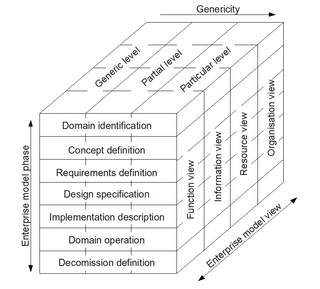


ISO 19439:2006 Enterprise integration—Framework for enterprise modelling, is an international standard for enterprise modelling and enterprise integration developed by the International Organization for Standardization, based on CIMOSA and GERAM.[1]
ISO 19439 framework wants to provide a "unified conceptual basis for model-based enterprise engineering that enables consistency, convergence and interoperability of the various modelling methodologies and supporting tools. The framework does not encompass methodological processes; it is neutral in this regard".[2]
This standard specifies a framework, which "serves as a common basis to identify and coordinate standards development for modelling of enterprises, but not restricted to, computer integrated manufacturing. It also serves as the basis for further standards for the development of models that will be computer-enactable and enable business process model-based decision support leading to model-based operation, monitoring and control".[3]
According to David Shorter (2004)[1] the ISO19439 is alike CIMOSA, and has defines three dimensions for enterprise modelling: